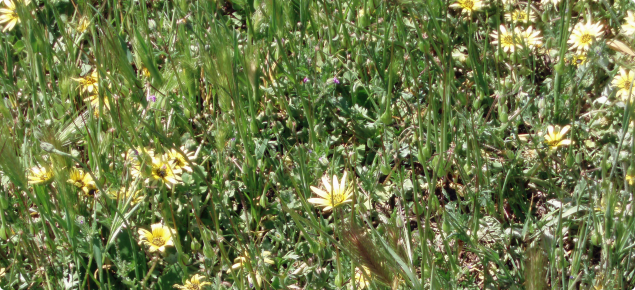Identification and attributes
Latin name - Arctotheca calendula
Distinguishing features
Capeweed is a prostrate, stemless, sprawling annual herb that germinates during autumn and winter. It has hairless, club-shaped cotyledons. The first two leaves grow as a pair, are spear-shaped and may be scalloped. Subsequent leaves grow singly and are deeply lobed with a rounded apex. Leaves are succulent, the upper surface is hairy and the lower surface is covered with a mat of white hairs.
Solitary ‘daisy-like’ flower heads are brilliant yellow (ray florets) with blackish purple central disc florets. Seeds are covered in pink–brown fluffy, woolly hairs.
Biology
This species favours ‘false breaks’. Low-rainfall events lend themselves to capeweed germination before other species, because the woolly seed cover attracts moisture and reduces desiccation. It can also survive periods of drought better than most crops and pastures, so a dry period following germinating rains increases the proportion of capeweed.
Autumn rains induce germination of capeweed if the soil surface remains wet for a few days. Subsequent rain and residual soil moisture continue to support growth of seedlings and these will persist through winter crops if not killed before crop sowing. The woolly hair around the seed assists early germination.
Secondary dormancy, a combination of embryo and seedcoat-based dormancy, may be initiated by low winter temperatures. Long-term dormancy is dependent on regional adaptation. In WA more than 95% of capeweed seed from the southern agricultural area germinated on the soil surface at the break of season. Only 5% of seed from the northern agricultural area germinated during the first year and 75% in the second season, with 20% remaining dormant for more than two years. Dormancy cycled to favour autumn germination.
Why is it a weed?
Capeweed competes with crops (cereals, pulses, canola) for water, nutrients and probably light, resulting in yield reduction. Plants emerging during early autumn become large before the crop is sown and compete strongly with the crop. A plant at rosette stage can be as big as 600 millimetres in diameter and can outcompete any other plants shorter than capeweed plants. Such large plants are difficult to control with herbicides. They are often transplanted during sowing and their re-emergence with crop plants can lead to population levels that decrease crop yield.
In WA, competition from 7-90 capeweed plants/m2 in a wheat crop can reduce crop yield by 28-44% and net return by 25-76%. A capeweed plant growing under favourable conditions can produce up to 4000 seeds.
Capeweed is often associated with scouring in sheep and can also cause nitrate and nitrite poisoning of livestock, particularly ruminants. Nasal granuloma may occur in cows that inhale air with high concentrations of capeweed pollen for long periods.
Herbicide resistance
Although there are no cases of resistance in WA, capeweed has developed resistance to diquat and paraquat (Group L) in Victoria and 2,4-D (Group I) in South Australia.


